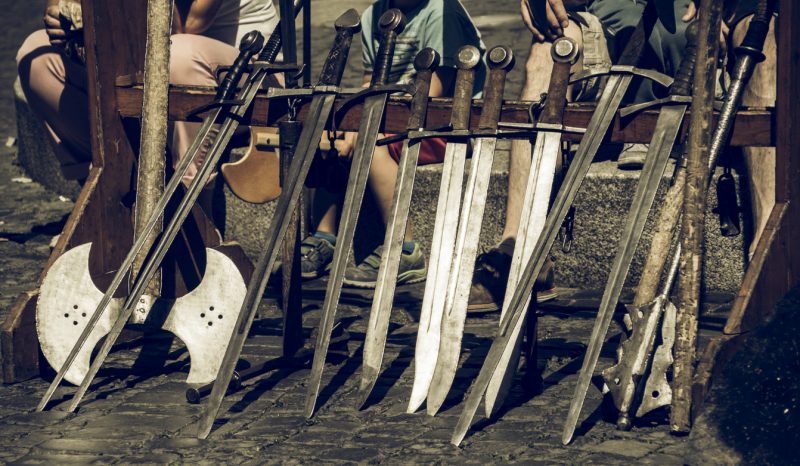The Fantastic Find
The Battle of Visby in 1361 was not a particularly important battle in history. An army of Danes led by their king, Valdemar IV, invaded the island of Gotland in Sweden for its strategic location within the Baltic Sea.
They would be met by an army of peasants, many being too young or too old for battle. This force of desperate villagers trying to save their home would be slaughtered outside the city’s walls.
This sad conflict would have remained largely forgotten by the world if Dr. Oscar Wennersten hadn’t unearthed a mass grave from the site in 1905. After a string of excavations lasting until 1928, archaeologists would uncover the remains of 1,185 people in several more grim graves.
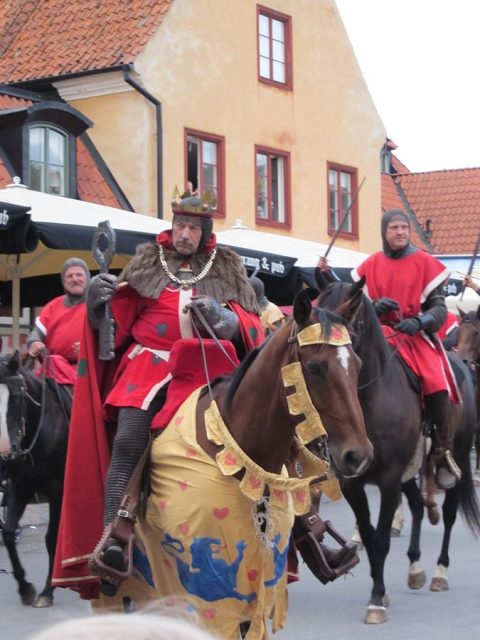
The finding was exceptional; it was the first scientific study and excavation of a mass grave, a morbid scene that contained within it an impressive collection of medieval weapons and armor.
Much of the almost 700-year-old equipment remained wrapped around the bones of their former owners, chainmail coifs still enveloping the skulls of fallen warriors. But this was extremely unusual. Medieval weapons and armor of this quality and quantity are not easy to find.
For an era marked by its brutal battles and consistent warfare, why is it so difficult to find the relics of such a bloody history? There is no definite answer, no documents that show the fate of the tools wielded and worn by medieval warriors. Clues may be found, however, in human ingenuity, tradition, and practicality.
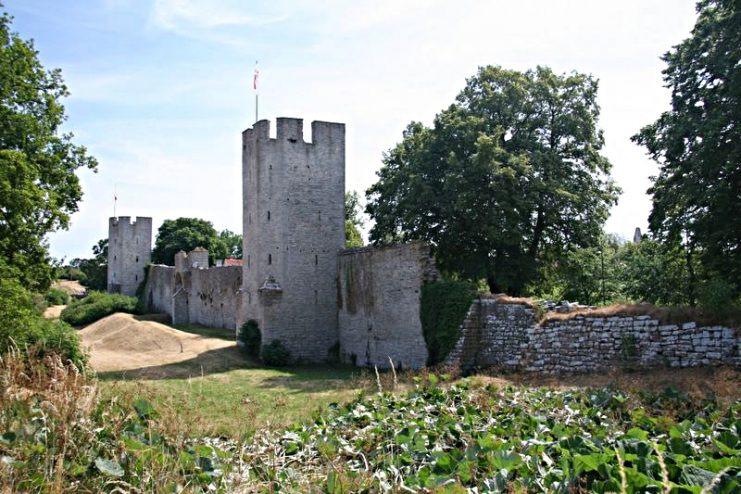
The Survival of Swords
Under the right conditions, a sword can be well preserved within the sediment of a lake or riverbed, and the biochemical process occurring within a bog can preserve metals and even human tissue.
Most things found in these environments are of an earlier time, suggesting that the deposit of objects in these places was based in religious traditions pre-dating Christianity.
Recently, a 14th-century sword was found accidentally within a peat bog, but the circumstances leading to the blade being left there seems to be more a product of tragedy than ceremony.
Pagan cultures would often place their dead, particularly those of the warrior and nobility classes, within tombs and graves after cremation. The idea of the dead traveling to another world was important, and traditions of ritualistic burials were meant to reflect this.
Such travelers would need their equipment for the voyage and what may lie afterward, so the burial of weapons, armor, and tokens of prestige would be placed alongside the body. The lack of moisture in these environments would keep these things well preserved, making their finds much more frequent.
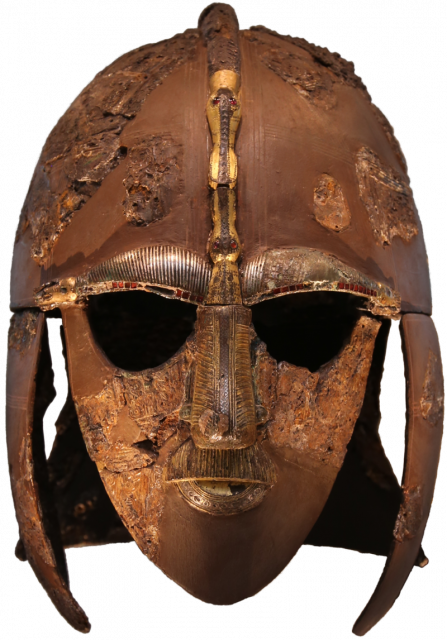
Along with the tradition of burying weapons and armor with the dead, pagan rituals were often performed with votive offerings. Many weapons have been found on river beds and in bogs. While some could be the result of battles fought near such waters, most are assumed to be a part of this tradition — that of casting such valuables away.
Sometimes blades are found bent or purposely damaged, a sign of ritualistic destruction.
Artifacts from the Bronze and Iron Age, including shields, helmets, and swords, have been found scattered within the lands of Europe, and the Viking Age has provided some of the best quality examples of iron and steel weapons ever found.
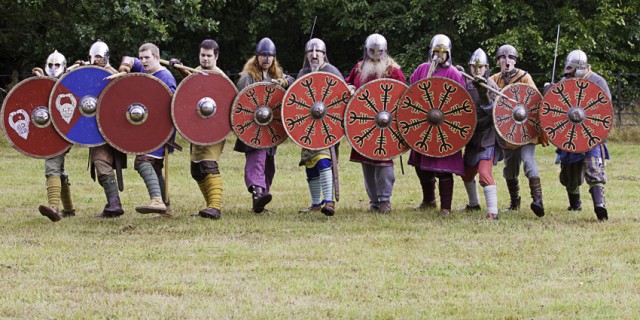
The Middle Ages, it would be assumed, should have produced more of these findings, being of a date closer to our own and marked by higher levels of organization and technology. But as Europe began to shift culturally towards Christianity, what was considered important began to change as well.
This attitude was the start of a transition from pagan to Christian traditions, a clue that helps us to examine the fate of medieval artifacts of war.
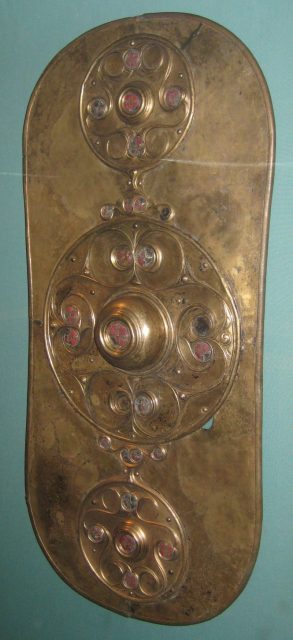
Two swords have been found in the River Witham in England. One, a Viking style sword dated to around the 10th century, contains an inscription upon the blade: +LEUTLRIT.
The other is of a Medieval design, forged in the late 13th or early 14th century, but it bears a similar and even stranger inscription: +NDXOXCHWDRGHDXORVI+.
These letters have remained a mystery since its discovery in 1825, but the similar pattern of inscription and location might suggest the continuation of an ancient practice rooted in Britain’s Celtic and Anglo-Saxon past.
Religious significance is implied by the crosses flanking the unusual writing, and while the casting of blades into bodies of water may have been forgotten or condemned, religious inscriptions would continue to be practiced in the Middle Ages. For high-quality smiths, this would often have been a part of the job.
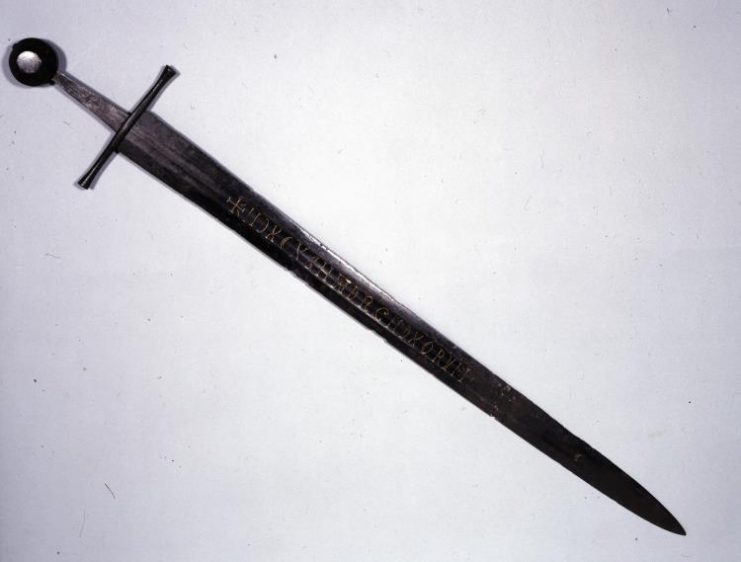
Knights, Peasants, and Soldiers
While weapons would continue to be symbols of status, their relevance would be seen in more practical and authoritative ways. Burying a good sword and well-made armor with their deceased owner made no sense. The loss of such quality equipment was simply not worth the cost of old traditions.
There was a need for these things given the level of warfare being waged during the Medieval period, and the sword of a fallen knight could be sharpened and placed in the hands of another warrior rather than buried with him and lost forever.
The making of steel at any level was a laborious job. Soldiers, knights, and peasants were expected to bring most of their own equipment, so the common man-at-arms would often wear leather or cloth armor, sometimes riveted with steel or iron strips for added protection.
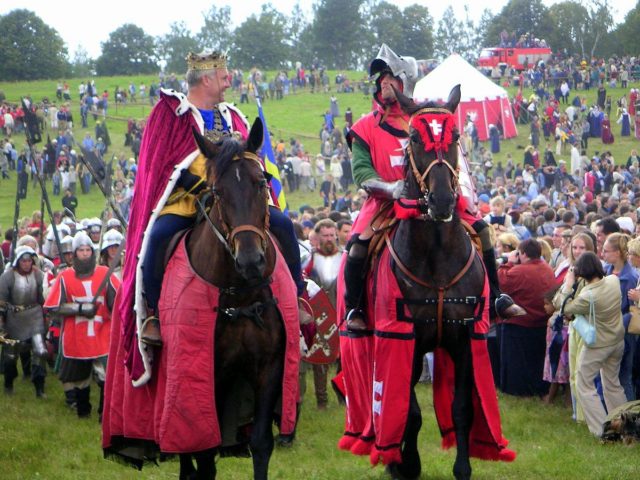
Farming weapons repurposed for war might be brought by conscripted peasants, as well as modified billhooks and bows repurposed for war. It was a much more affordable form of soldiering, bringing the tools of work and trade while wearing cheaper, less durable materials for armor.
To pick a decent breastplate off a fallen foe or friend would be worth the effort. Quality weapons could be repaired and re-sharpened, cracks in armor patched and mended. Recycling was a necessary part of life in the Middle Ages, and little could go to waste.
These things would trade hands, whether it was scavenged off a corpse or passed down as an heirloom.
Although medieval forges could rarely reach the level of heat required for melting steel, pieces could be welded or reworked into other equipment with proper heat. A scythe for cutting wheat or barley had a chance of being made from a forgotten blade.

It’s unrealistic to think that, after a battle, the weapons and armor of war would simply be left to rot. Even the cheapest sword would still be of a high enough quality to keep such a prize durable, valuable, and deadly.
After the Battle of Visby, it is believed that the weather was too hot to scavenge the battlefield. If the heat had not been so disagreeable, the archaeologists might have found nothing but bones.
The improvised weaponry of the average medieval warrior would return to being tools of the worker at the end of a war.
Whatever professional equipment that was left would have already been stashed away in armories to collect dust, while those deemed more important would be preserved for their relevance and value as ornamental artifacts.
In any event, a new type of warrior would require more modern equipment that would suit the changing landscape of battle.
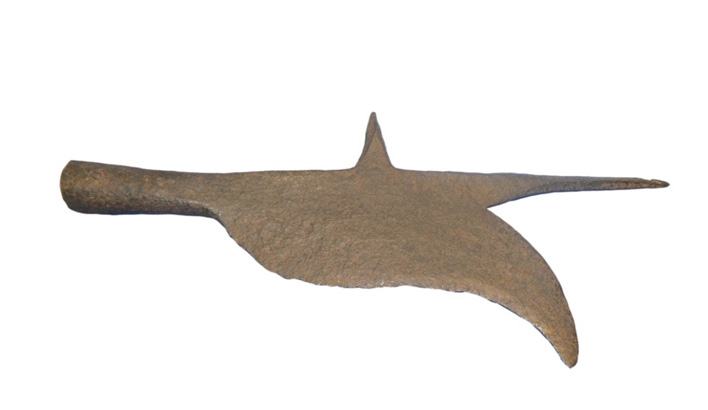
Changing Times and Changing Minds
Henry V’s victory at Agincourt in 1415 was won by his archers armed with longbows. The early 14th century battles of Bannockburn and Morgarten displayed the capabilities of an organized formation of infantry armed with pikes.
An English army at the Battle of Castillon in 1453 would be defeated by a French force brandishing 300 cannons and handguns, blowing them away in a hail of cannonballs and gunfire.
Warfare was changing rapidly due to the increasing prevalence of gunpowder weapons. The cavalry charge of knights in shining armor was being replaced by disciplined infantry with pikes and handguns.
Professional mercenaries and standing armies would dominate the centuries to follow, meaning that the mass production of armor and weapons was necessary to fit out these more uniform soldiers.
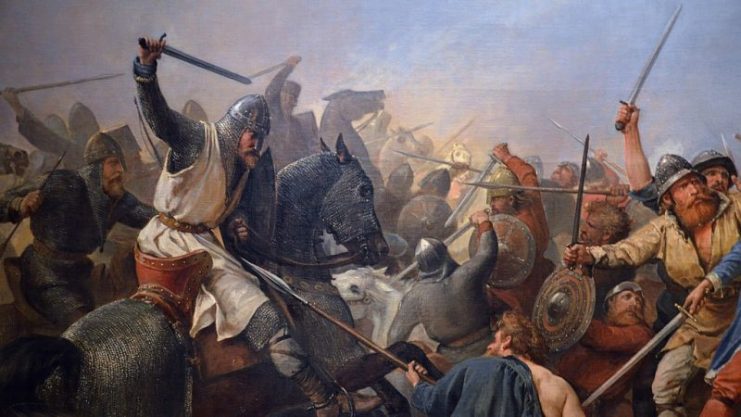
CC BY-SA 4.0
Iron armor could usually be made well enough to resist a musket ball in the right conditions, and gunpowder weapons were both easy to use and cheap to produce.
Quality construction of steel armor continued as a craft, but the practicality of plate and chainmail armor for war was quickly becoming obsolete.
Gradually, armor transformed from protective equipment to works of art. Most of the pristine displays seen in museums and armories are rarely older than the 15th century, reflecting the new attitudes of a rapidly changing time.
By the 17th century, warfare had become an organized affair revolving around the common soldier as he became armed with increasingly deadlier weapons.
By the 18th century, armor was close to being phased out completely, being relegated to cavalry for melee engagements and as symbols of military rank. Now the average soldier was a professional, dressed in colorful uniforms and armed with a flintlock musket and bayonet, ready for any occasion.
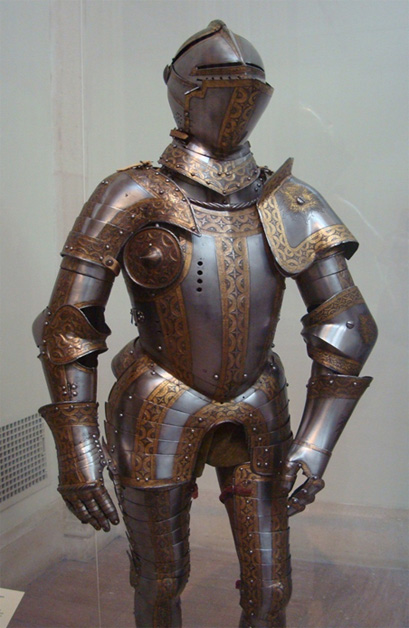
Stuck in the Middle
“Medieval” and” Middle Ages” are monikers coined by the modern world to describe a time that was considered to be an in-between period for civilization. In most ways this is wrong.
The cultural developments of this fascinating time period are often overlooked. The vibrancy, beauty, and social achievements of the time are often masked by a cruel, gray world as portrayed in movies and TV shows.
It is correct, however, to see the Middle Ages as a period unique in its own development, a time of great flux and innovation.
Important changes occurred during the Middle Ages. The pressure upon a more segmented society made it a time of continuous change and war. What was carried into battle was representative of the time: practical solutions for complicated problems that often resulted in violence.
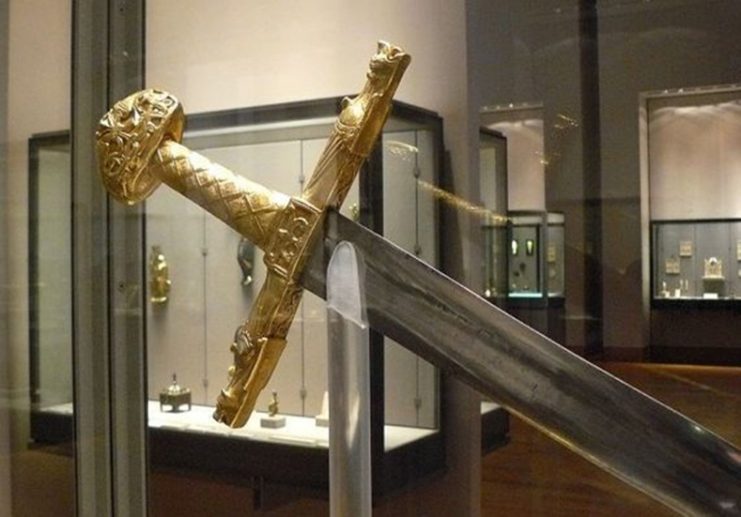
Gradually, the Medieval world advanced, and practicality gave way to the Renaissance.
Most of the displays of what have been called medieval arms and armor are mostly from this time. When the practice of making plate armor reached its apex, it simultaneously approached more artistic and ornamental purposes.
Much of the armor seen in collections is meant to be exactly as it seems: displays of exemplary craftsmanship. By the time of the modern army, what was left of medieval weapons and armor had been collected or forgotten in the armories and castles of lords and kings.
Read another story from us: Badgers Unearth Medieval Anglo-Saxon Warrior Burial Site
When looking for relics of this time period, it is important to distinguish the cultural attitudes and capabilities of the time.
Professional and organized warfare as seen by the development of gunpowder weapons made the medieval levy systems obsolete, and armies now required the mass production of cheaper but more effective equipment.
But what remains, what has been found and preserved, continues to be an awe-inspiring link to this tumultuous time that still captivates the imagination.
